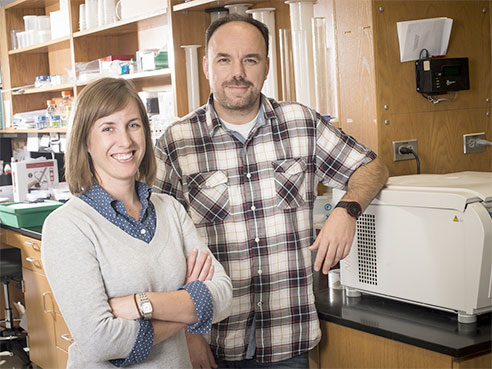 Jill Butler and Marek NapieralaUniversity of Alabama at Birmingham researchers have received funding to seek and validate biomarkers for the progressive, inherited disease Friedreich’s ataxia, a life-shortening degenerative neuromuscular disorder.
Jill Butler and Marek NapieralaUniversity of Alabama at Birmingham researchers have received funding to seek and validate biomarkers for the progressive, inherited disease Friedreich’s ataxia, a life-shortening degenerative neuromuscular disorder.
“There is a high demand for biomarkers because of ongoing clinical trials with Friedreich’s ataxia patients,” said Marek Napierala, Ph.D., assistant professor in UAB Department of Biochemistry and Molecular Genetics, UAB Stem Cell Institute. “We need better measures of the progression of the disease and the therapeutic response.”
Napierala and Jill Butler, Ph.D., instructor in Biochemistry and Molecular Genetics, are co-investigators on this two-year, $140,000-a-year grant, which is funded by the nonprofit Friedreich’s Ataxia Research Alliance and FARA Ireland.
A biomarker, or biological marker, is an objective way to measure a normal biological state, a disease process or the response to therapy. Common examples are blood pressure, cholesterol levels, or checking a child’s temperature when he or she feels ill.
Discovery of validated biomarkers is a high priority for FARA because they are invaluable to help speed the development and clinical evaluation of potential drugs. The Friedreich’s ataxia treatment pipeline already includes nine potential drugs or treatments that are in human clinical trials, seven more that are in preclinical testing, and four others in the early discovery phase.
About one in 50,000 people in the United States lives with Friedreich’s ataxia. Most experience onset of symptoms between the ages 5 and 18 years, beginning with a stumbling or staggering gait and falls. Degeneration of spinal cord neurons and cardiomyopathy are two hallmarks of this debilitating disease. Progressive loss of coordination and muscle strength leads to motor incapacitation and full-time use of a wheelchair after approximately 10 to 15 years from disease onset.
Napierala and Butler use a sophisticated approach in their hunt for biomarkers. They collect cells from Friedreich’s ataxia patients and transform them into induced pluripotent stem cells (iPSCs). These iPSCs are similar to embryonic stem cells in that they can differentiate into every other cell type in the body. At UAB, said Butler, “we have collected a repository of fibroblasts from skin biopsies of more than 50 Friedreich’s ataxia patients and numerous unaffected individuals.”
| About one in 50,000 people in the United States lives with Friedreich’s ataxia. Most experience onset of symptoms between the ages 5 and 18 years, beginning with a stumbling or staggering gait and falls. Degeneration of spinal cord neurons and cardiomyopathy are two hallmarks of this debilitating disease. |
In preliminary work for the grant application, Butler and Napierala looked at RNA gene expression in patient and control fibroblast cells. They identified several gene expression variants as candidate biomarkers, and they now are working to validate those candidates in neuronal and cardiac Friedreich’s ataxia cell line models and to adapt these biomarkers for routine testing in a clinical setting. They measure protein expression levels using reverse phase protein arrays, and they have future plans to look for changes in microRNAs in the Friedreich’s ataxia cells. MicroRNAs are short sequences of RNA that act as robust agents of gene regulation in cells.
“For this research to be successful and make it to the clinic,” Napierala said, “the test or measurement needs to be easily done.” Ideal biomarkers also have to be safe, cost effective and easily adapted from research laboratory testing to the clinic.
“Identification of novel biomarkers is a high priority to FARA,” said FARA Executive Director Jennifer Farmer. “We anticipate that the research being conducted by Drs. Napierala and Butler will elucidate new Friedreich’s ataxia-specific biomarkers that can be used to measure response to treatment or better predict response to specific therapeutic interventions, both in vitro during preclinical testing and in vivo during clinical trials. FARA is also most appreciative of this research team for their collaborative efforts to establish a well-characterized Friedreich’s ataxia cell bank that can be shared with the research community.”
About one in every 100 people carries the recessive mutation for Friedreich’s ataxia, but the disease occurs only in people who receive two copies of this mutation — one from the mother and one from the father. The mutations reduce the expression of the protein frataxin, which functions in the mitochondria of the cells. Mitochondria are small organelles within cells where respiration and energy production take place. Progressive deficiency of frataxin causes the damage to sensitive neuronal and cardiac cells.
